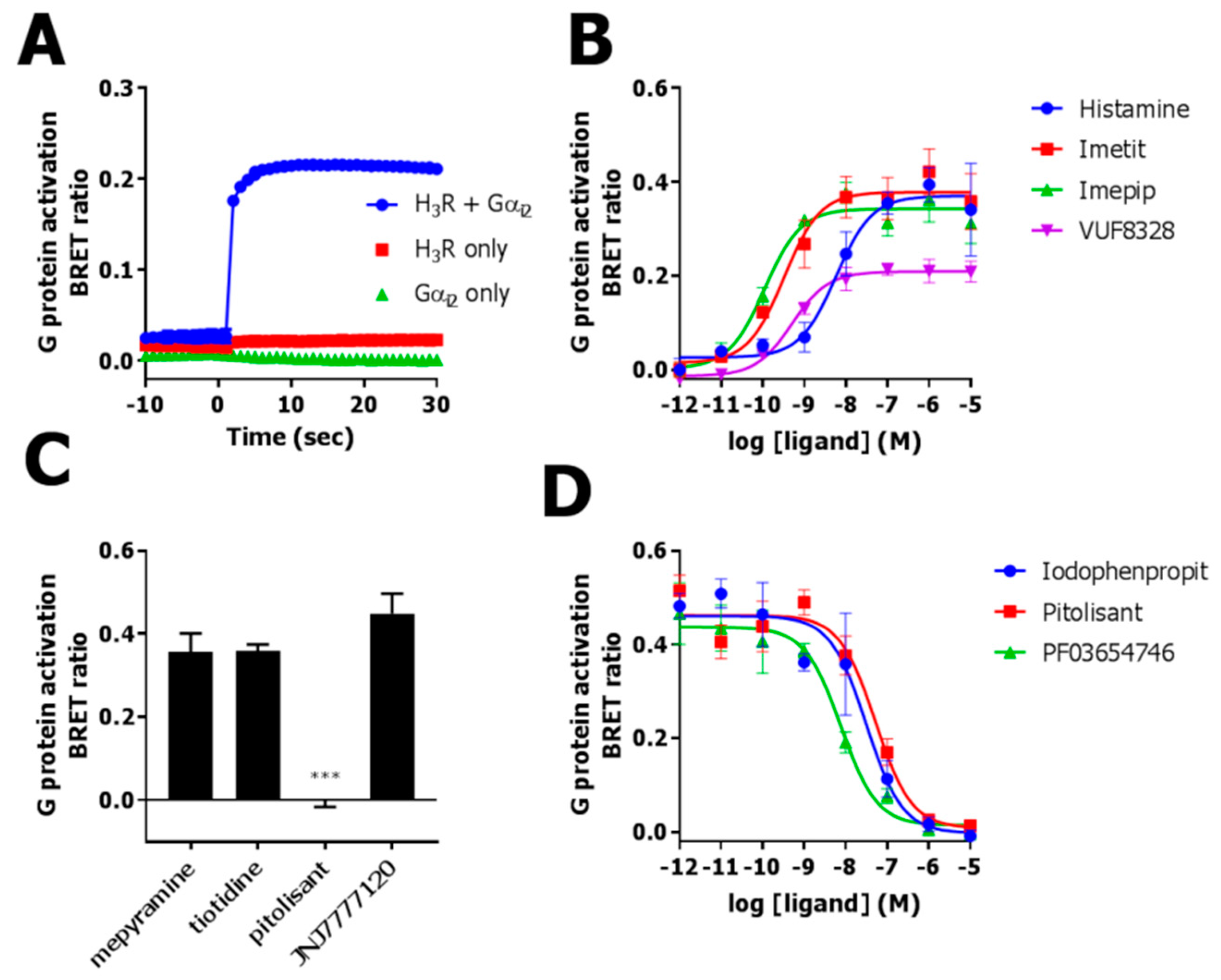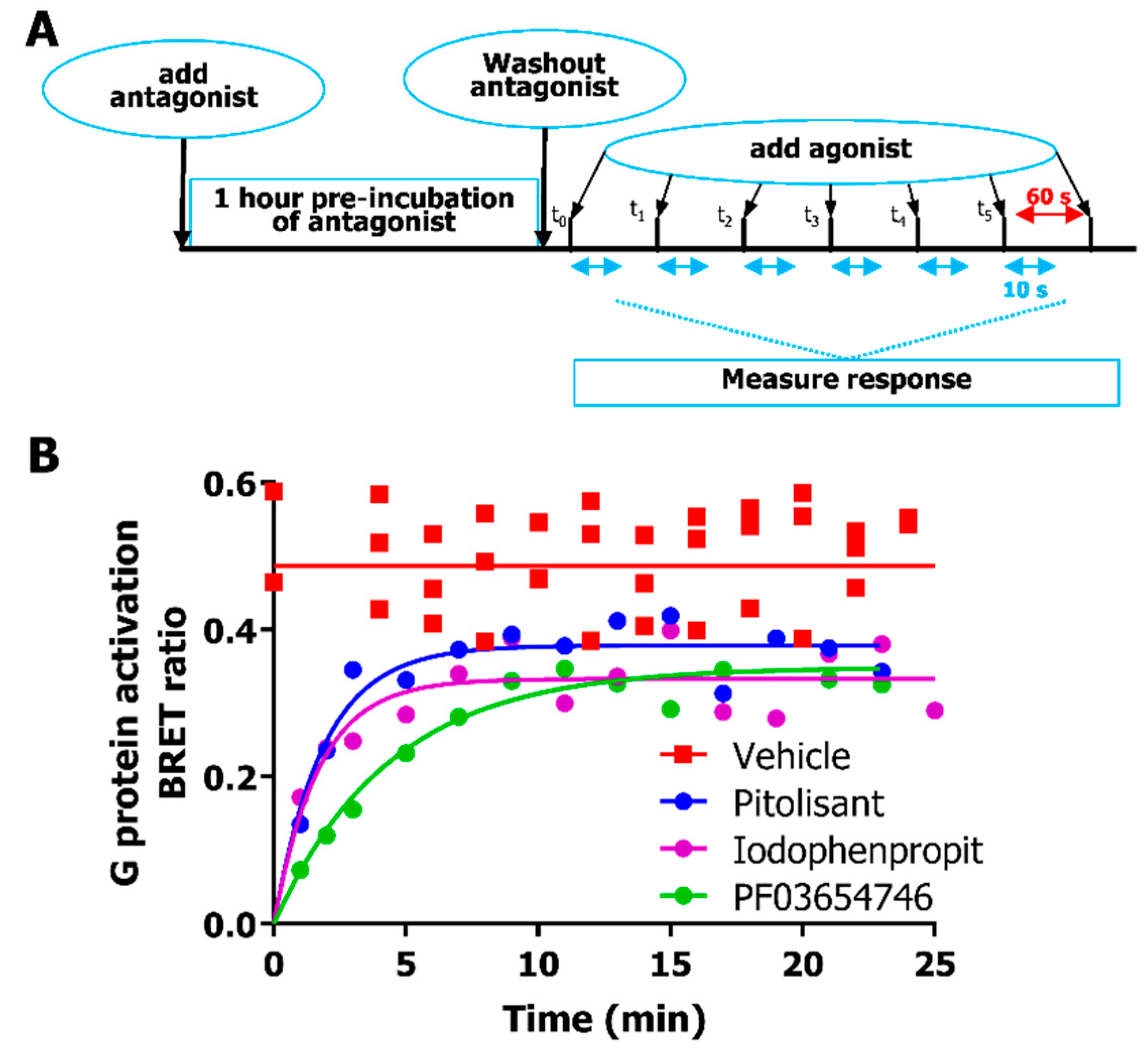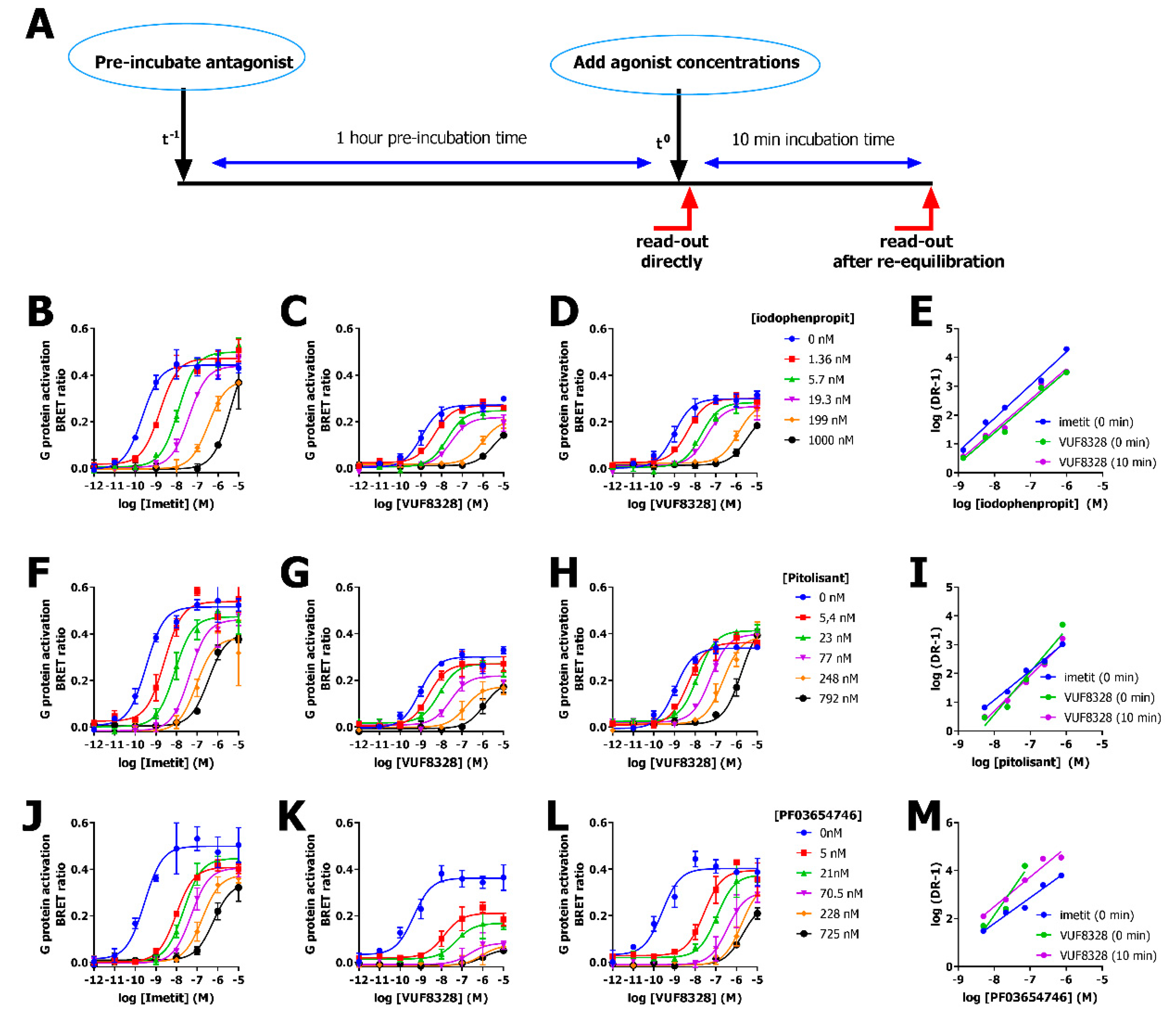Bioluminescence Resonance Energy Transfer Based G Protein-Activation Assay to Probe Duration of Antagonism at the Histamine H3 Receptor
Abstract
1. Introduction
2. Results
2.1. BRET between Venus-Gβ1γ2 and masGRK3ct-Nluc to Measure hH3R-Induced Gαi2 Activation
2.2. Duration of Functional hH3R Antagonism
2.3. Re-Equilibration Time Determines Whether hH3R Antagonism is Insurmountable or Surmountable
3. Discussion
4. Materials and Methods
4.1. Materials
4.2. Cell Culture and Transfection
4.3. BRET between Venus-Gβ1γ2 and masGRK3ct-Nluc to Measure H3R-Induced Gαi2 Activation
4.4. Data Analysis
Author Contributions
Funding
Conflicts of Interest
Abbreviations
| α | Intrinsic activity |
| ADHD | Attention deficit hyperactivity disorder |
| ANOVA | Analysis of variance |
| BRET | Bioluminescence resonance energy transfer |
| cAMP | cyclic Adenosine-MonoPhosphate |
| DMEM | Dulbecco’s Modified Eagles Medium |
| DMR | Dynamic mass redistribution |
| DR | Dose ratio |
| GPCR | G protein-coupled receptor |
| FBS | Fetal bovine serum |
| H1R | Histamine H1 receptor |
| H3R | Histamine H3 receptor |
| HEK | Human embryonic kidney |
| hERG | Human ether-a-go-go related gene |
| hH3R | Human H3R |
| IC50 | Concentration inhibitor needed to reduce response by 50% |
| koff | Dissociation rate constant |
| masGRK3ct | membrane-associated-C-terminal fragment of G protein-coupled receptor kinase 3 |
| Nluc | NanoLuc luciferase |
| pEC50 | −log (EC50) where EC50 is concentration required to obtain half maximal response |
| pKi | −log Ki, where Ki is the equilibrium dissociation constant |
| RecT | Recovery time |
References
- Copeland, R.A.; Pompliano, D.L.; Meek, T.D. Drug-target residence time and its implications for lead optimization. Nat. Rev. Drug Discov. 2006, 5, 730–739. [Google Scholar] [CrossRef] [PubMed]
- Sykes, D.A.; Stoddart, L.A.; Kilpatrick, L.E.; Hill, S.J. Binding kinetics of ligands acting at GPCRs. Mol. Cell. Endocrinol. 2019, 485, 9–19. [Google Scholar] [CrossRef] [PubMed]
- Mocking, T.A.M.; Verweij, E.W.E.; Vischer, H.F.; Leurs, R. Homogeneous, Real-Time NanoBRET Binding Assays for the Histamine H3 and H4 Receptors on Living Cells. Mol. Pharmacol. 2018, 94, 1371–1381. [Google Scholar] [CrossRef] [PubMed]
- Bouzo-Lorenzo, M.; Stoddart, L.A.; Xia, L.; IJzerman, A.P.; Heitman, L.H.; Briddon, S.J.; Hill, S.J. A live cell NanoBRET binding assay allows the study of ligand-binding kinetics to the adenosine A3 receptor. Purinergic Signal. 2019, 139–153. [Google Scholar] [CrossRef] [PubMed]
- Stoddart, L.A.; Vernall, A.J.; Bouzo-Lorenzo, M.; Bosma, R.; Kooistra, A.J.; de Graaf, C.; Vischer, H.F.; Leurs, R.; Briddon, S.J.; Kellam, B.; et al. Development of novel fluorescent histamine H1-receptor antagonists to study ligand-binding kinetics in living cells. Sci. Rep. 2018, 8, 1572. [Google Scholar] [CrossRef] [PubMed]
- Bosma, R.; Stoddart, L.A.; Georgi, V.; Bouzo-Lorenzo, M.; Bushby, N.; Inkoom, L.; Waring, M.J.; Briddon, S.J.; Vischer, H.F.; Sheppard, R.J.; et al. Probe dependency in the determination of ligand binding kinetics at a prototypical G protein-coupled receptor. Sci. Rep. 2019, 9, 7906. [Google Scholar] [CrossRef] [PubMed]
- Bosma, R.; Witt, G.; Vaas, L.A.I.; Josimovic, I.; Gribbon, P.; Vischer, H.F.; Gul, S.; Leurs, R. The target residence time of antihistamines determines their antagonism of the G protein-coupled histamine H1 receptor. Front. Pharmacol. 2017, 8, 1–15. [Google Scholar] [CrossRef]
- Bosma, R.; van den Bor, J.; Vischer, H.F.; Labeaga, L.; Leurs, R. The long duration of action of the second generation antihistamine bilastine coincides with its long residence time at the histamine H1 receptor. Eur. J. Pharmacol. 2018, 838, 107–111. [Google Scholar] [CrossRef]
- Nederpelt, I.; Kuzikov, M.; De Witte, W.E.A.; Schnider, P.; Tuijt, B.; Gul, S.; IJzerman, A.P.; De Lange, E.C.M.; Heitman, L.H. From receptor binding kinetics to signal transduction; a missing link in predicting in vivo drug-action. Sci. Rep. 2017, 7, 14169. [Google Scholar] [CrossRef]
- Doornbos, M.L.J.; Cid, J.M.; Haubrich, J.; Nunes, A.; Van De Sande, J.W.; Vermond, S.C.; Mulder-Krieger, T.; Trabanco, A.A.; Ahnaou, A.; Drinkenburg, W.H.; et al. Discovery and Kinetic Profiling of 7-Aryl-1,2,4-triazolo[4,3-a]pyridines: Positive Allosteric Modulators of the Metabotropic Glutamate Receptor 2. J. Med. Chem. 2017, 60, 6704–6720. [Google Scholar] [CrossRef]
- Slack, R.J.; Russell, L.J.; Hall, D.A.; Luttmann, M.A.; Ford, A.J.; Saunders, K.A.; Hodgson, S.T.; Connor, H.E.; Browning, C.; Clark, K.L. Pharmacological characterization of GSK1004723, a novel, long-acting antagonist at histamine H 1 and H 3 receptors. Br. J. Pharmacol. 2011, 164, 1627–1641. [Google Scholar] [CrossRef] [PubMed]
- Lindström, E.; von Mentzer, B.; Påhlman, I.; Ahlstedt, I.; Uvebrant, A.; Kristensson, E.; Martinsson, R.; Novén, A.; de Verdier, J.; Vauquelin, G. Neurokinin 1 Receptor Antagonists: Correlation between in Vitro Receptor Interaction and in Vivo Efficacy. J. Pharmacol. Exp. Ther. 2007, 322, 1286–1293. [Google Scholar] [CrossRef] [PubMed]
- Bosma, R.; Moritani, R.; Leurs, R.; Vischer, H.F. BRET-based β-arrestin2 recruitment to the histamine H1 receptor for investigating antihistamine binding kinetics. Pharmacol. Res. 2016, 111, 679–687. [Google Scholar] [CrossRef] [PubMed]
- Masuho, I.; Ostrovskaya, O.; Kramer, G.M.; Jones, C.D.; Xie, K.; Martemyanov, K.A. Distinct profiles of functional discrimination among G proteins determine the actions of G protein-coupled receptors. Sci. Signal. 2015, 8, 1–16. [Google Scholar] [CrossRef] [PubMed]
- Hollins, B.; Kuravi, S.; Digby, G.J.; Lambert, N.A. The c-terminus of GRK3 indicates rapid dissociation of G protein heterotrimers. Cell. Signal. 2009, 21, 1015–1021. [Google Scholar] [CrossRef] [PubMed]
- Panula, P.; Chazot, P.L.; Cowart, M.; Gutzmer, R.; Leurs, R.; Liu, W.L.S.; Stark, H.; Thurmond, R.L.; Haas, H.L. International Union of Basic and Clinical Pharmacology. XCVIII. Histamine Receptors. Pharmacol. Rev. 2015, 67, 601–655. [Google Scholar] [CrossRef] [PubMed]
- Ghamari, N.; Zarei, O.; Arias-Montaño, J.A.; Reiner, D.; Dastmalchi, S.; Stark, H.; Hamzeh-Mivehroud, M. Histamine H3 receptor antagonists/inverse agonists: Where do they go? Pharmacol. Ther. 2019, 200, 69–84. [Google Scholar] [CrossRef]
- Kuhne, S.; Wijtmans, M.; Lim, H.D.; Leurs, R.; de Esch, I.J. Several down, a few to go: Histamine H3 receptor ligands making the final push towards the market? Expert Opin. Investig. Drugs 2011, 20, 1629–1648. [Google Scholar] [CrossRef]
- Sadek, B.; Łażewska, D.; Hagenow, S.; Kieć-Kononowicz, K.; Stark, H. Histamine H3R Antagonists: From Scaffold Hopping to Clinical Candidates. In Histamine Receptors: Preclinical and Clinical Aspects; Blandina, P., Passani, M.B., Eds.; Springer International Publishing: Cham, Switzerland, 2016; pp. 109–155. [Google Scholar]
- Stokes, J.R.; Romero, F.A.; Allan, R.J.; Phillips, P.G.; Hackman, F.; Misfeldt, J.; Casale, T.B. The effects of an H 3 receptor antagonist (PF-03654746) with fexofenadine on reducing allergic rhinitis symptoms. J. Allergy Clin. Immunol. 2012, 129, 409–412. [Google Scholar] [CrossRef]
- Kollb-Sielecka, M.; Demolis, P.; Emmerich, J.; Markey, G.; Salmonson, T.; Haas, M. The European Medicines Agency review of pitolisant for treatment of narcolepsy: Summary of the scientific assessment by the Committee for Medicinal Products for Human Use. Sleep Med. 2017, 33, 125–129. [Google Scholar] [CrossRef]
- Romigi, A.; Vitrani, G.; Lo Giudice, T.; Centonze, D.; Franco, V. Profile of pitolisant in the management of narcolepsy: Design, development, and place in therapy. Drug Des. Dev. Ther. 2018, 12, 2665–2675. [Google Scholar] [CrossRef] [PubMed]
- Bioprojet: Pitolisant Progresses Towards The U.S. Market. Available online: http://www.bioprojet.com/en/article/harmony-fda-2/ (accessed on 5 July 2019).
- Wieland, K.; Bongers, G.; Yamamoto, Y.; Hashimoto, T.; Yamatodani, A.; Menge, W.M.B.P.; Timmerman, H.; Lovenberg, T.W.; Leurs, R. Constitutive Activity of Histamine H3 Receptors Stably Expressed in SK-N-MC Cells: Display of Agonism and Inverse Agonism by H3 Antagonists. J. Pharmacol. Exp. Ther. 2001, 299, 908–914. [Google Scholar] [PubMed]
- Lim, H.D.; van Rijn, R.M.; Ling, P.; Bakker, R.A.; Thurmond, R.L.; Leurs, R. Evaluation of histamine H1-, H2-, and H3-receptor ligands at the human histamine H4 receptor: Identification of 4-methylhistamine as the first potent and selective H4 receptor agonist. J. Pharmacol. Exp. Ther. 2005, 314, 1310–1321. [Google Scholar] [CrossRef] [PubMed]
- Vauquelin, G.; Van Liefde, I.; Birzbier, B.B.; Vanderheyden, P.M.L. New insights in insurmountable antagonism. Fundam. Clin. Pharmacol. 2002, 16, 263–272. [Google Scholar] [CrossRef] [PubMed]
- Kenakin, T.; Jenkinson, S.; Watson, C. Determining the potency and molecular mechanism of action of insurmountable antagonists. J. Pharmacol. Exp. Ther. 2006, 319, 710–723. [Google Scholar] [CrossRef] [PubMed]
- Schuetz, D.A.; De Witte, W.E.A.; Wong, Y.C.; Knasmueller, B.; Richter, L.; Kokh, D.B.; Sadiq, S.K.; Bosma, R.; Nederpelt, I.; Heitman, L.H.; et al. Kinetics for Drug Discovery: An industry-driven effort to target drug residence time. Drug Discov. Today 2017, 22, 896–911. [Google Scholar] [CrossRef] [PubMed]
- Vanderheyden, P.M.L.; Benachour, N. Influence of the cellular environment on ligand binding kinetics at membrane-bound targets. Bioorg. Med. Chem. Lett. 2017, 27, 3621–3628. [Google Scholar] [CrossRef]
- Wijtmans, M.; Leurs, R.; de Esch, I. Histamine H3 receptor ligands break ground in a remarkable plethora of therapeutic areas. Expert Opin. Investig. Drugs 2007, 16, 967–985. [Google Scholar] [CrossRef]
- Sykes, D.A.; Parry, C.; Reilly, J.; Wright, P.; Fairhurst, R.A.; Charlton, S.J. Observed Drug-Receptor Association Rates Are Governed by Membrane Affinity: The Importance of Establishing “Micro-Pharmacokinetic/Pharmacodynamic Relationships” at the 2-Adrenoceptor. Mol. Pharmacol. 2014, 85, 608–617. [Google Scholar] [CrossRef]
- Riddy, D.M.; Cook, A.E.; Shackleford, D.M.; Pierce, T.L.; Mocaer, E.; Mannoury la Cour, C.; Sors, A.; Charman, W.N.; Summers, R.J.; Sexton, P.M.; et al. Drug-receptor kinetics and sigma-1 receptor affinity differentiate clinically evaluated histamine H3 receptor antagonists. Neuropharmacology 2019, 144, 244–255. [Google Scholar] [CrossRef]
- Mould, R.; Brown, J.; Marshall, F.H.; Langmead, C.J. Binding kinetics differentiates functional antagonism of orexin-2 receptor ligands. Br. J. Pharmacol. 2014, 171, 351–363. [Google Scholar] [CrossRef] [PubMed]
- Van der Goot, H.; Schepers, M.; Sterk, G.; Timmerman, H. Isothiourea analogues of histamine as potent agonists or antagonists of the histamine H3-receptor. Eur. J. Med. Chem. 1992, 27, 511–517. [Google Scholar] [CrossRef]
- Jansen, F.P.; Wu, T.S.; Voss, H.P.; Steinbusch, H.W.M.; Vollinga, R.C.; Rademaker, B.; Bast, A.; Timmerman, H. Characterization of the binding of the first selective radiolabeled histamine H3-receptor antagonist, [125I]-iodophenpropit, to rat brain. Br. J. Pharmacol. 1994, 113, 355–362. [Google Scholar] [CrossRef] [PubMed]
- Vollinga, R.C.; de Koning, J.P.; Jansen, F.P.; Leurs, R.; Menge, W.M.P.B.; Timmerman, H. A New Potent and Selective Histamine H3 Receptor Agonist, 4-(1H-imidazol-4-ylmethyl)piperidine. J. Med. Chem. 1994, 37, 332–333. [Google Scholar] [CrossRef] [PubMed]
- Bongers, G.; Krueger, K.M.; Miller, T.R.; Baranowski, J.L.; Estvander, B.R.; Witte, D.G.; Strakhova, M.I.; van Meer, P.; Bakker, R.A.; Cowart, M.D.; et al. An 80-Amino Acid Deletion in the Third Intracellular Loop of a Naturally Occurring Human Histamine H3 Isoform Confers Pharmacological Differences and Constitutive Activity. J. Pharmacol. Exp. Ther. 2007, 323, 888–898. [Google Scholar] [CrossRef] [PubMed]



| Compound | pEC50 ± S.E.M. | α | pKi a |
|---|---|---|---|
| Histamine | 8.3 ± 0.0 | 1.0 ± 0.0 | 6.7 |
| Imetit | 9.6 ± 0.1 | 1.1 ± 0.1 | 8.6 |
| immepip | 9.9 ± 0.1 | 1.0 ± 0.1 | 8.8 |
| VUF8328 | 9.4 ± 0.1 | 0.7 ± 0.2 | 8.5 |
| Compound | pKB a | pKi b | Imetit (0 min) | VUF8328 (0 min) | VUF8328 (10 min) | RecT c (min) | |||
|---|---|---|---|---|---|---|---|---|---|
| pA2 | Slope | pA2 | Slope | pA2 | Slope | ||||
| Iodophenpropit | 9.5 ± 0.1 | 9.4 | 9.6 ± 0.0 | 1.1 ± 0.0 | 9.3 ± 0.2 | 1.1 ± 0.1 | 9.5 ± 0.3 | 1.1 ± 0.1 | 1.4 ± 0.2 |
| Pitolisant | 9.1 ± 0.0 | 8.9 | 8.9 ± 0.1 | 1.1 ± 0.0 | 8.4 ± 0.0 | 1.4 ± 0.0 | 8.7 ± 0.2 | 1.1 ± 0.1 | 1.7 ± 0.3 |
| PF03,654,746 | 9.9 ± 0.1 | 9.3 | 9.8 ± 0.1 | 1.0 ± 0.1 | 9.3 ± 0.2 | 1.5 ± 0.2 | 9.6 ± 0.2 | 1.2 ± 0.1 | 3.6 ± 0.3 |
© 2019 by the authors. Licensee MDPI, Basel, Switzerland. This article is an open access article distributed under the terms and conditions of the Creative Commons Attribution (CC BY) license (http://creativecommons.org/licenses/by/4.0/).
Share and Cite
Mocking, T.A.M.; Buzink, M.C.M.L.; Leurs, R.; Vischer, H.F. Bioluminescence Resonance Energy Transfer Based G Protein-Activation Assay to Probe Duration of Antagonism at the Histamine H3 Receptor. Int. J. Mol. Sci. 2019, 20, 3724. https://doi.org/10.3390/ijms20153724
Mocking TAM, Buzink MCML, Leurs R, Vischer HF. Bioluminescence Resonance Energy Transfer Based G Protein-Activation Assay to Probe Duration of Antagonism at the Histamine H3 Receptor. International Journal of Molecular Sciences. 2019; 20(15):3724. https://doi.org/10.3390/ijms20153724
Chicago/Turabian StyleMocking, Tamara A. M., Maurice C. M. L. Buzink, Rob Leurs, and Henry F. Vischer. 2019. "Bioluminescence Resonance Energy Transfer Based G Protein-Activation Assay to Probe Duration of Antagonism at the Histamine H3 Receptor" International Journal of Molecular Sciences 20, no. 15: 3724. https://doi.org/10.3390/ijms20153724
APA StyleMocking, T. A. M., Buzink, M. C. M. L., Leurs, R., & Vischer, H. F. (2019). Bioluminescence Resonance Energy Transfer Based G Protein-Activation Assay to Probe Duration of Antagonism at the Histamine H3 Receptor. International Journal of Molecular Sciences, 20(15), 3724. https://doi.org/10.3390/ijms20153724





